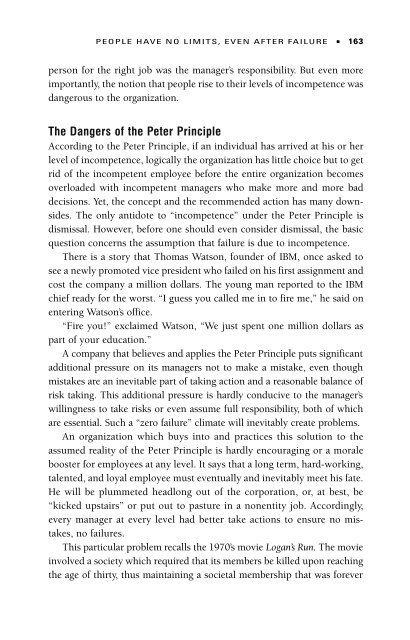A Class with Drucker - Headway | Work on yourself
A Class with Drucker - Headway | Work on yourself
A Class with Drucker - Headway | Work on yourself
Create successful ePaper yourself
Turn your PDF publications into a flip-book with our unique Google optimized e-Paper software.
PEOPLE HAVE NO LIMITS, EVEN AFTER FAILURE ■ 163<br />
pers<strong>on</strong> for the right job was the manager’s resp<strong>on</strong>sibility. But even more<br />
importantly, the noti<strong>on</strong> that people rise to their levels of incompetence was<br />
dangerous to the organizati<strong>on</strong>.<br />
The Dangers of the Peter Principle<br />
According to the Peter Principle, if an individual has arrived at his or her<br />
level of incompetence, logically the organizati<strong>on</strong> has little choice but to get<br />
rid of the incompetent employee before the entire organizati<strong>on</strong> becomes<br />
overloaded <str<strong>on</strong>g>with</str<strong>on</strong>g> incompetent managers who make more and more bad<br />
decisi<strong>on</strong>s. Yet, the c<strong>on</strong>cept and the recommended acti<strong>on</strong> has many downsides.<br />
The <strong>on</strong>ly antidote to “incompetence” under the Peter Principle is<br />
dismissal. However, before <strong>on</strong>e should even c<strong>on</strong>sider dismissal, the basic<br />
questi<strong>on</strong> c<strong>on</strong>cerns the assumpti<strong>on</strong> that failure is due to incompetence.<br />
There is a story that Thomas Wats<strong>on</strong>, founder of IBM, <strong>on</strong>ce asked to<br />
see a newly promoted vice president who failed <strong>on</strong> his first assignment and<br />
cost the company a milli<strong>on</strong> dollars. The young man reported to the IBM<br />
chief ready for the worst. “I guess you called me in to fire me,” he said <strong>on</strong><br />
entering Wats<strong>on</strong>’s office.<br />
“Fire you!” exclaimed Wats<strong>on</strong>, “We just spent <strong>on</strong>e milli<strong>on</strong> dollars as<br />
part of your educati<strong>on</strong>.”<br />
A company that believes and applies the Peter Principle puts significant<br />
additi<strong>on</strong>al pressure <strong>on</strong> its managers not to make a mistake, even though<br />
mistakes are an inevitable part of taking acti<strong>on</strong> and a reas<strong>on</strong>able balance of<br />
risk taking. This additi<strong>on</strong>al pressure is hardly c<strong>on</strong>ducive to the manager’s<br />
willingness to take risks or even assume full resp<strong>on</strong>sibility, both of which<br />
are essential. Such a “zero failure” climate will inevitably create problems.<br />
An organizati<strong>on</strong> which buys into and practices this soluti<strong>on</strong> to the<br />
assumed reality of the Peter Principle is hardly encouraging or a morale<br />
booster for employees at any level. It says that a l<strong>on</strong>g term, hard-working,<br />
talented, and loyal employee must eventually and inevitably meet his fate.<br />
He will be plummeted headl<strong>on</strong>g out of the corporati<strong>on</strong>, or, at best, be<br />
“kicked upstairs” or put out to pasture in a n<strong>on</strong>entity job. Accordingly,<br />
every manager at every level had better take acti<strong>on</strong>s to ensure no mistakes,<br />
no failures.<br />
This particular problem recalls the 1970’s movie Logan’s Run. The movie<br />
involved a society which required that its members be killed up<strong>on</strong> reaching<br />
the age of thirty, thus maintaining a societal membership that was forever


